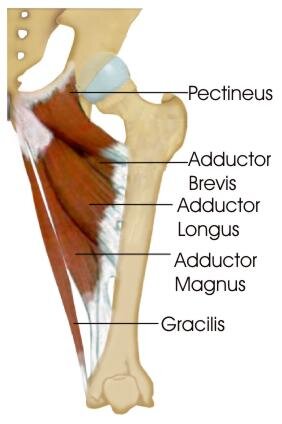Let’s learn more about the hip adductor muscles!
This post is dedicated to the group of muscles on the inside of your thigh. They are often neglected which is unfortunate because of how much they can affect your mobility. Hopefully, after reading this blog post, you will better understand the anatomy of your hip adductors and why you should start paying attention to them!
Why are they called the hip “adductors"?” The word adductor describes the action of these muscles and it comes from the Latin words “ad”, which means “toward” and “ducere”, which means “to lead”. The hip adductor muscle group is made up of the Pectineus, Gracilis, Adductor Brevis, Adductor Longus, and last but certainly not least, the Adductor Magnus.
Pectineus: Assists in both adduction and flexion of the femur at the hip joint.
Adductor Brevis: Primary function is adduction of the thigh at the hip joint, but it also assists in flexion and medial rotation of the femur at the hip joint.
Adductor Longus: Primarily function is adduction of the thigh at the hip joint, but it also also assists in flexion and medial rotation of the femur at the hip joint.
Gracilis: Primary action is adduction of the thigh, but it also assists in flexion of the knee and medial rotation of that flexed knee.
Adductor Magnus: Primary functions are adduction and medial rotation of the thigh at the hip joint. The anterior fibers of the adductor magnus also assist in hip flexion and the posterior fibers assist in hip extension. Because of its location and action, it’s sometimes referred to as the 4th hamstring muscle. This one seems a bit more complicated than the other hip adductor muscles…right? I think so…so let’s talk more about it!
Let’s shine a brighter light on the Adductor Magnus(AM) for a minute. It has a complex anatomical arrangement which gives it many roles as well as many ways it can impact mobility. It acts as a hip extensor, hip adductor, and pelvic stabilizer, and is often found to be tight and overactive in many individuals.
Located on the medial side and posterior side of the thigh and is often considered as having three separate anatomical and functional components. The three different components, because of the fiber alignment, have different movement roles! Example: The front part of the muscle, the “pubofemoral” portion, works to flex and adduct the hip. The middle portion mainly adducts the hip. The back portion, the “hamstring portion” mainly extends the hips.
Due to the complex pelvic attachment of the AM, the muscle has a sweep or curve shape to it. This structure allows it to act as a major pelvic stabilizer as our hips flex in weight bearing – for example squatting down and bending over to pick something up off the floor.
Ironically, the AM is a more effective hip extensor than both the hamstrings and gluteus maximus when the hip is flexed. Since full squats have peak hip extensor contractions in a hip flexion position, the AM can be trained very effectively in these movements.
Adductor Magnus and dysfunctional movement:
Unfortunately, there has not been a great deal of research done on the AM compared to some of the more flashy muscles. However! Due to it’s complex anatomical arrangement and its tendency for over-use and over-activity, it is thought to be home to many myofascial trigger points, tightness, and restrictions. That’s where I come in…yahoo (yahoo for me…not necessarily for you🤷♀️)!
My fellow PTs out there- be sure not to forget about the AM when attempting to figure out the cause of muscle imbalances and dysfunctional movement. Let’s think about one movement in particular: The use of the AM to produce hip extension could have a significant effect on lower limb kinematics during squatting or other lower body heavy lifting movements. Think about someone whose knees medially deviate on the initial part of the ascent during the deep squat (referred to as a ‘valgus collapse’ of the knees)…an overactive AM and underactive glutes could be the culprit here.
SO…What can YOU do to prevent or address hip adductor muscle tightness and overactivity?
Try: Self-stretching techniques, self-myofascial release techniques, and move your body more! *Studies show a significant increase in active and passive groin ROM and maximal voluntary isometric contraction after just 60 seconds of foam rolling before exercise.
Is the dysfunction persisting or is pain present? Seek the help of a Physical Therapist!
Questions? Contact Plus Forte today!
Email: courtney@plusforte.co
Phone: 978-590-6951
References:
Connoly, G. et al. (2020). A Single Bout of Foam Rolling Increases Flexibility of the Hip Adductor Muscles without Compromising Strength. International Journal of Exercise Science, 13(7), pp. 938-949.
Mallac, C. (n.d.). Adductor Magnus: Tales of Tightness. Sports Injury Bulletin. Retrieved February 20, 2021 from https://www.sportsinjurybulletin.com/adductor-magnus-tales-of-tightness.



